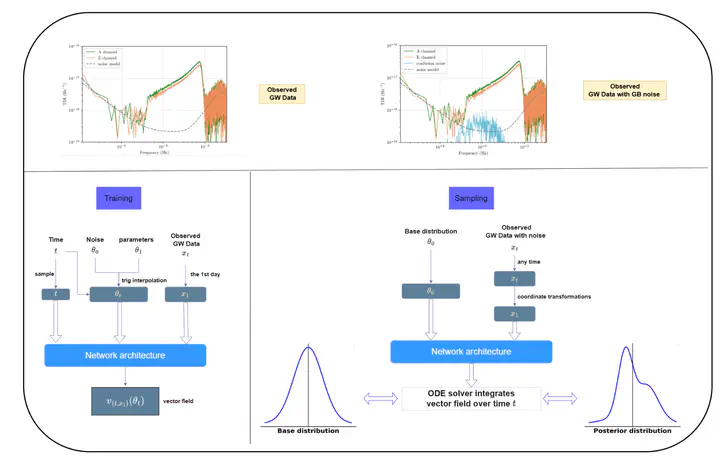Rapid Parameter Estimation for Merging Massive Black Hole Binaries Using Continuous Normalizing Flows
 The Diagrams for the training and sampling phases of our model. On the lower left, the training phase is displayed, where t denotes time and x1 represents the data from the first day of observed MBHBs. In this phase, a feature extractor, as detailed in section 3.1, processes the data to produce a final vector field. This vector field enables the network architecture to learn a transformation from a base distribution (θ0, sampled from a Gaussian distribution) to a posterior distribution (θ1, sampled from the posterior distribution). On the lower right, the sampling phase is shown. Here, the data with noise (xt), which includes both confusion noise and instrumental noise from MBHB observations at any time, is mapped back to the first day’s data x1 using the coordinate transformation described in section 3.2. The Gaussian distribution is then converted into a posterior distribution by solving the ordinary differential equation (ODE) with the vector field learned during the training phase. The top of the image displays simulation data from both the training and sampling phases.
The Diagrams for the training and sampling phases of our model. On the lower left, the training phase is displayed, where t denotes time and x1 represents the data from the first day of observed MBHBs. In this phase, a feature extractor, as detailed in section 3.1, processes the data to produce a final vector field. This vector field enables the network architecture to learn a transformation from a base distribution (θ0, sampled from a Gaussian distribution) to a posterior distribution (θ1, sampled from the posterior distribution). On the lower right, the sampling phase is shown. Here, the data with noise (xt), which includes both confusion noise and instrumental noise from MBHB observations at any time, is mapped back to the first day’s data x1 using the coordinate transformation described in section 3.2. The Gaussian distribution is then converted into a posterior distribution by solving the ordinary differential equation (ODE) with the vector field learned during the training phase. The top of the image displays simulation data from both the training and sampling phases.